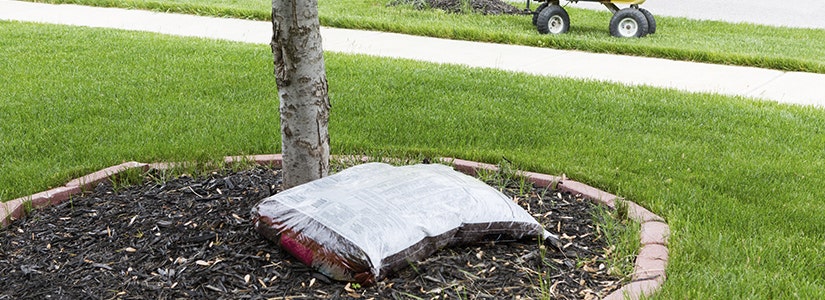

- Home
- Solution Center
- Learn
- Learn: Tree & Shrub
- Winter Tree Care
Winter Tree Care
Although trees are dormant during winter, they're not protected from the elements like a hibernating animal that holes up in a snug spot. Trees experience the raw intensity of the cold season. Wintry conditions can be stressful on trees, especially newly-planted or young trees that lack mature defense mechanisms such as a wide, spreading root system or thick bark. Learn how to protect trees and help them survive the winter season and thrive in years to come.
Mulch
In late fall to early winter, add a thin layer (no more than 2 inches) of organic mulch beneath your tree's drip line. Mulch insulates soil and tree roots against temperature extremes and slows water loss from soil. Don't pile mulch directly against the tree trunk. Wait to mulch until the ground freezes to prevent mice from making your mulch their winter quarters.
Water
Keep trees, especially newly-planted ones, well-watered through fall – until the ground freezes. Before freezing temperatures, remove irrigation bags surrounding the tree trunk. If a warm spell thaws trees and soil, water newly-planted trees, especially if your region is in the midst of a prolonged drought.
Spray
Winter sun and wind create drying conditions for broadleaf evergreens, such as Pieris, Rhododendron or Mountain Laurel. Spray an anti-desiccant, which covers leaves with a waxy coating, to reduce moisture loss.
Wrap
When winter sun thaws a tree trunk by day and cold night air freezes it, bark cells can rupture, creating cracks in the trunk. This condition is called sunscald. To protect trees, cover trunks with crepe paper tree wrap. Working from the bottom, wrap the trunk, overlapping layers by one-third. Stop wrapping just above lowest branches. Remove the wrap in spring. You can also paint the tree trunk white or wrap it with a white plastic rabbit guard. Sunscald occurs most often on trees planted on west or south sides of buildings.
Protect
Rabbits and voles love to gnaw the bark on young trees. Typically they'll consume outer and inner bark, exposing inner wood. If chewing damage occurs halfway around the trunk, the tree likely won't survive. Block rodents by wrapping trunks with plastic tree guards, starting at the bottom and working upward. Be sure to wrap past the snow line. Remove the wrap in spring. Another option is to cage trunks with chicken wire, which will also prevent deer from rubbing. Once bark matures and develops fissures, the small critters usually stop chewing.
Melt
Keep rock salt (sodium chloride) away from trees. Rock salt interferes with roots' ability to absorb water, oxygen and nutrients. Choose ice melt products containing calcium, potassium or magnesium chloride.
Clear
Accumulating snow on tree branches can break them. To remove snow, gently push it off limbs using upward movements. Don't try to break ice off branches. Instead, use a garden hose connected to a hot water faucet, but take care not to burn the plant.
Prune
Winter provides a great opportunity for inspecting and pruning trees. You can easily see the tree's structure and identify problem branches. If trees overhang perennial or vegetable gardens, pruning those trees in winter won't damage your plantings. Pruning during dormancy can also prevent disease spread, since disease organisms are also dormant. Learn more about how to inspect trees for potential hazards, as well as when to prune trees.














